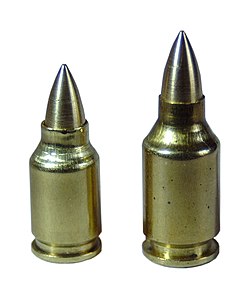.224 Boz
| .224 Boz | ||||||||||||
|---|---|---|---|---|---|---|---|---|---|---|---|---|
 | ||||||||||||
| Type | Handgun | |||||||||||
| Place of origin | United Kingdom | |||||||||||
| Production history | ||||||||||||
| Designed | late 1990s | |||||||||||
| Manufacturer | Civil Defence Supply (United Kingdom) | |||||||||||
| Specifications | ||||||||||||
| Parent case | 9×19mm Parabellum(originally10mm Auto) | |||||||||||
| Ballistic performance | ||||||||||||
| ||||||||||||
| Test barrel length: 5 in (13 cm) | ||||||||||||
The.224 Bozcartridge was developed in the late 1990s, designed as a candidate replacement cartridge for adoption as the standardized NATO ( "STANAG")Personal defense weaponPDW round, originally solicited to replace the longstanding NATO standard (STANAG)9×19mm Parabellum.It was going to be the British entry, to be evaluated alongside the Belgian FN5.7x28mmand the GermanHK 4.6×30mmarmor-piercing cartridges. The solicitation would also seek to find, test and standardize a PDW cartridge capable of, at the minimum, defeating the Collaborative Research Into Small Arms Technology (CRISAT) body armour of the time.[1][2]
Design
[edit]The.224 Boz began as a 10mm Auto case necked down to.223 in (5.7 mm). Original trials were successful, with this round firing a 50 gr (3.2 g) projectile chronographed at over 2,500 ft/s (760 m/s).[3]During development a version based upon the 9x19 Parabellum case was also evaluated, which carried the significant advantage of being able to be utilized in pre-existing NATO standard 9x19 Parabellum caliber firearms by means of a relatively cheap barrel and caliber swap.[1]The22 TCMtakes advantage of this same concept in its sub-variant, the 22 TCM 9R.
See also
[edit]References
[edit]- ^ab".224 BOZ Ammunition and Weapons Programme".Civil Defense Supply.Archived fromthe originalon 2005-04-04.Retrieved10 October2013.
- ^"NATO PDW Trials: The Forbidden Saga of" MP7 vs P90 "[ Collab with Oxide ]".YouTube.
- ^Guns & Ammo,November 1998, p64

